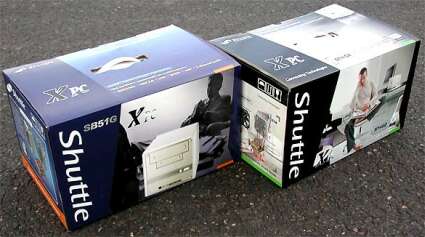Two New Mini-Powerhouses from Shuttle
Conclusion: Expandable PC Design With Good Craftsmanship
We discovered that both mini systems offer an outstanding standard of performance comparable to that of well-configured conventional PCs. Whereas the 3D graphics performance of older models was feeble, the Shuttle SN41G2 for the AMD platform attains respectable refresh rates - even for 3D gaming. If 3D graphics are important to you, you can also install a high-end AGP graphics board in either system.
At the end of the day, the Shuttle barebones offer excellent performance in a small, lightweight package. They also come furnished with every port under the sun, from FireWire to USB 2.0 right up to optical SP/DIF. And with their aluminum cases, these systems are real eye-catchers, especially considering the ho-hum grey plastic enveloping conventional clunkers.
Both computers have their own highlights. While the Intel systems with the 845GE chipset support P4 CPUs with HyperThreading functionality, the AMD system antes up with two VGA outputs and dual-channel DDR400. This fact alone shows that being compact doesn't doom PCs to having mediocre hardware.
Mini PCs catching up: with fast 3D graphics and a potent RAM interface, they'll soon be giving standard computers a run for their money.
That doesn't mean that Shuttle should rest on its laurels, though. There is room for improvement in some areas despite the fact that the current computers are very impressive. The main shortcoming of the mini PCs, and of the AMD system in particular, is the amount of operating noise they generate. In fact, the heat-pipe fan creates so much racket that we feel it's safe to say that this PC will not be gracing many offices any time soon. The same thing applies to the Intel system, although it doesn't have heat-dissipation problems on the same scale as the AMD machine. A sure-fire remedy would be a carefully developed thermal design that directed the airflow effectively. But that would involve a bold redesign that only major corporations such as Intel would be able to pull off.
Also, you ought to be able to manually set the temperature regulator on the fan without running the risk of overheating your processor. A few improvements are also in order on the aluminum case, which is made of such soft material that scratches sprout from it like daisies in summer. How about coating it with a protectant? In all other aspects, the outward appearance is ground-breaking and innovative.
Expandability is no problem, either. Each of the PCs comes with one PCI and one AGP slot. That should be sufficient in almost all cases. Except for a DVB board, a RAID controller or an AGP graphics card, almost all components have been integrated into the board. The hard-to-please will have to just go with a hulking PC behemoth instead.
Get Tom's Hardware's best news and in-depth reviews, straight to your inbox.
Wait a minute, Mr. Postman! The two barebone systems were delivered to us rather late.
You won't be seeing the first mini PCs at your local discounter any time soon. The extra cost of buying them compared to a run-of-the-mill system is just too high. Shuttle charges at least $400 for a barebone system. Take the necessary components into account and you'll quickly end up paying $1300 or more.
As the skeptics may point out, that's a big bill for a puny PC. But it's not too much for this bundle of power. After all, special, innovative products have always cost a little bit extra. We're looking forward to the next level of development, provided the manufacturer manages the logistics for the test machines properly.
Current page: Conclusion: Expandable PC Design With Good Craftsmanship
Prev Page SiSoft Sandra 2003 Benchmarks: CPU And Multimedia
